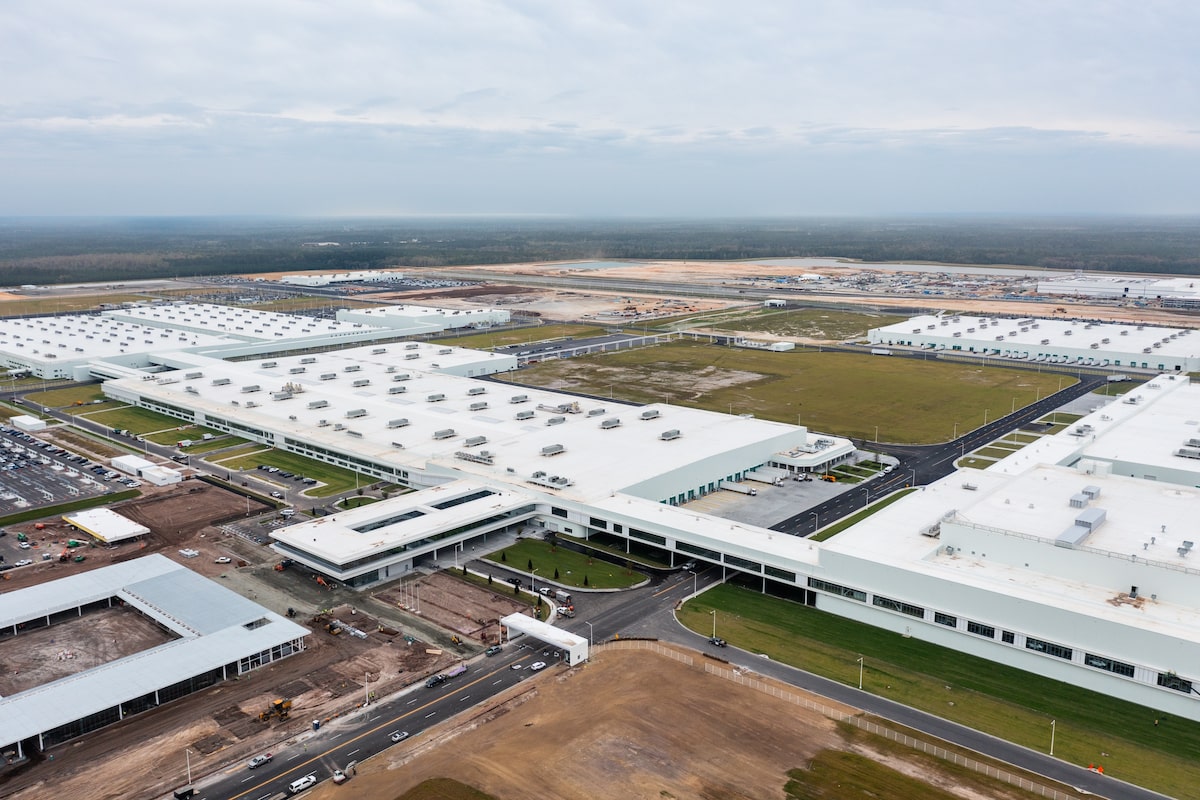Employment in U.S. swing states is growing thanks to a clean energy boom. Supporters worry it won’t last past the election
October 12, 2024

At the epicentre of America’s clean energy revolution, few people are eager to talk about whether the historically ambitious industrial strategy behind it will survive next month’s presidential election.
The state of Georgia seemingly has more of a vested interest in the future of the Inflation Reduction Act (IRA) – through which President Joe Biden’s administration is spending many hundreds of billions of dollars to try to make the United States a world leader in fighting climate change, curb reliance on China for new energy technologies and bring jobs back to corners of the country abandoned by traditional manufacturing – than just about any other place in America.
Since the legislation was passed in 2022, more than 30 related industrial projects cumulatively worth more than US$15-billion – primarily involving the electric-vehicle, battery and solar sectors – have been announced for Georgia. By some measures, that’s made it the biggest IRA beneficiary of all states; certainly, it’s in the top few, with companies attracted by factors that include helpful geography, an Atlantic port and low labour costs.
The new industrial foundations are already in view, from South Korea’s Qcells building North America’s largest solar-panel manufacturing hub in northwestern Georgia, to the landmark Hyundai Motor Co. EV-manufacturing site in the state’s southeast, to many smaller developments in between.
But Donald Trump is vowing to stop the strategy in its tracks. The Republican presidential nominee, who has repeatedly questioned the reality of climate change, calls the IRA a scam and has said he would roll back as much of it as possible.
It’s exactly the sort of fight that both parties have been expected to lean into – an opportunity for Democratic nominee Kamala Harris to accuse Mr. Trump of threatening to take away jobs, and for the Republicans to play to cultural conservatism and climate skepticism in one of the handful of swing states that will determine the White House’s next occupant.
How that battle plays out is of major economic and policy-making relevance not just across the U.S., but internationally. Many other countries have responded to the IRA’s combination of tax credits, grants and financing with similar plans of their own – not least Canada, which has introduced a federal green subsidy package worth more than $100-billion.
Now, governments around the world are watching closely to see whether there is a continued need to keep up, and to draw lessons about how such strategies play with voters.
But rather than Georgia being a flashpoint for perhaps the most consequential economic disagreement between the two presidential candidates, a mid-campaign visit by The Globe and Mail – just before Hurricane Helene’s toll on the state’s coast served as a reminder of increasingly frequent extreme weather that climate-friendly sectors are supposed to help minimize – encountered an odd reticence around the issue.
Some key beneficiaries, including project proponents normally eager to play up their investments and coming products, were reluctant to talk. Others did so guardedly, steering around discussion of current politics. Campaigning Democrats themselves acknowledged they’re not leading with the issue.
U.S President Joe Biden speaks about rural electrification and clean energy investments made through the IRA in Wisconsin, on Sept. 5, 2024. More than 30 related industrial projects cumulatively worth over U.S.$15-billion have been announced since the legislation’s passage in 2022.Scott Olson/Getty Images
That’s not out of step with how the issue has played nationally during the campaign. Neither Ms. Harris nor Mr. Trump has spent much time talking about it, including in their televised debate. And polls have showed that fewer than half of Americans even know what the IRA is, despite projections that it could ultimately involve over US$1-trillion in spending.
Georgia, though, makes for a particularly interesting case study. How can there be such quiet around the issue, and so little willingness to promote and stand up for the IRA, even where the impacts and the stakes are so visceral?
The answer, based on interviews with industry representatives, activists and politicians willing to speak at length on the subject, is an odd combination: fear about over-aligning with a strategy that the electorate may not welcome, and optimism that there actually is mounting support for the clean-energy strategy so long as it doesn’t get pulled too deeply into the culture wars.
“There’s definitely a lot of collective holding of breath right now,” said Stacey Mixson, a lead representative for the International Brotherhood of Electrical Workers in central Georgia, about the nervousness.
Mr. Mixson’s union, which gets work during construction of factories, has endorsed Ms. Harris and has been actively playing up the IRA’s benefits. He made it sound like a somewhat lonely undertaking, acknowledging that some of his local’s members are uncomfortable with going out on a limb that others have avoided, for fear of putting targets on their backs if Mr. Trump is elected.
That’s frustrating for some clean energy advocates. “I think a lot of companies should be doing more, and speaking out more,” said Bob Keefe, a former Atlanta Journal-Constitution reporter who is now executive director of E2, a national environmental alliance of business leaders.
The more counterintuitive hope is that a quiet and fragile cross-partisan consensus around clean industries may be taking hold, if it can survive election season.
“It’s not a top-tier issue, and I think that’s good,” said Solarcycle Inc. co-founder Jesse Simons, whose company has announced an approximately US$350-million factory to make new glass for solar panels from recycled materials in Cedartown, Ga. “The fact that there isn’t a huge amount of controversy around it, that people don’t see it as some kind of wedge issue, I think that’s a sign that it’s probably going to last.”
Brionte McCorkle, environmental activist and executive director of Georgia Conservation Voters, which engages voters in the democratic process to advocate for environmental protections.Elijah Nouvelage/The Globe and Mail
There are nationwide phenomena shaping both the trepidation and the cautious optimism, atop Georgia-specific ones.
One worry is about retribution if companies or industries are perceived to align with the Democrats, and then Mr. Trump wins back the White House.
Some recent history adds to that concern. Brionté McCorkle, executive director of Georgia Conservation Voters and one of the state’s most high-profile environmental activists, invoked the cautionary tale of Solyndra Corp. The solar panel manufacturer defaulted on a loan guarantee in 2011, under a smaller round of green stimulus by then-president Barack Obama’s administration, and became nationally infamous when Republicans invoked it as evidence of the whole strategy’s failure (despite the loan program ultimately coming out ahead financially).
The last thing anyone wants, Ms. McCorkle said, is to become that sort of political lightning rod if their project runs into problems.
As for why Democrats aren’t promoting the IRA more loudly, the reluctance owes partly to a view that despite the legislation’s name, its fire-hosing of public dollars could be blamed for cost-of-living concerns that are a high priority for many voters.
Green jobs may not resonate with enough people to outweigh the affordability worry and, in some cases, concerns about new industry straining local infrastructure, according to Democrats. Patti Hewitt, a congressional candidate for the party in the Savannah, Ga., area, noted that jobs that have been promised but not yet filled are especially difficult to campaign on.
At the same time, some sanguineness comes from IRA beneficiaries hoping that even if Mr. Trump wins the White House, he won’t have enough congressional backing to repeal much of the legislation – particularly the investment and production tax credits that make up the bulk of its industrial support.
“Once people are making money, and there are jobs, I just think it’s really hard to walk it back,” said Solarcycle’s Mr. Simons.
He pointed to a letter signed by 18 Republicans in the House of Representatives this summer – including Buddy Carter, who represents the Georgia district where Ms. Hewitt is running, and where the Hyundai plant is being built – calling for the tax credits to be kept in place.
The other, more philosophical reason for optimism about tacit Republican support for some IRA measures is economic nationalism.
If there is one area of quiet cross-partisan agreement in Washington, it’s around seeking to onshore jobs while limiting China’s dominance of emerging energy sectors.
That’s subtext, for instance, for the lack of debate around investments such as the US$2.8-billion by Qcells to build 8.4 gigawatts of solar manufacturing capacity (about 16 million panels annually) in northern Georgia, backed by billions of dollars in federal subsidies and financing.
MEGAN VARNER/Reuters
Solar panels are built at the QCells solar energy manufacturing factory in Dalton, Ga., in March 2023. Following the passage of the IRA, South Korea’s QCells began building North America’s largest solar-panel manufacturing hub in northwestern Georgia.Mike Stewart/The Associated Press
Marta Stoepker, Qcells’ North American communications director, partly attributed the company entering the state – with a 1.7 GW factory in the city of Dalton, Ga. – to tariffs on solar imports imposed by Mr. Trump, who was in office when that plant was announced in 2018.
Then, Ms. Stoepker said, the IRA’s incentives under Mr. Biden helped prompt a US$2.5-billion commitment (much larger than the initial investment) to put down deeper roots. That includes expansions to the Dalton site, to roughly triple the initial capacity.
It also includes a uniquely comprehensive solar manufacturing facility set to open in 2025 in Cartersville, Ga. Rather than just assembling solar modules, as in Dalton, the Cartersville site – backed by a US$1.4-billion loan guarantee from the U.S. Department of Energy – will also manufacture panel components such as silicon wafers that are usually imported from China. That’s a way of maximizing the value of IRA tax credits that reward the use of domestic parts.
“We are an example of what non-partisan policy can look like,” Ms. Stoepker said.
That’s a reference both to the national level and to the state government. Georgia Governor Brian Kemp, a Republican, has walked an odd line of criticizing the IRA as overly prescriptive economic policy and downplaying concern around climate change, while himself embracing the job-creating potential of low-carbon manufacturing through measures such as tax incentives and job-training programs.
A Hyundai Ioniq 5 electric SUV is displayed at the World Climate Industry Expo in September, 2024. The vehicle is now being produced at Hyundai’s Savannah, Ga. factory.ANTHONY WALLACE/AFP/Getty Images
It’s a similar story near Savannah, where Hyundai’s US$7.6-billion plant just started making Ioniq 5 electric SUVs.
That project, too, was announced before the IRA, though Mr. Biden was already in office and using other policies (such as stricter regulations around tailpipe emissions) to boost the EV market. And the initiative was expanded, including through a partnership with LG Energy Solution Ltd. to produce batteries for the vehicles on the same site, after the passage of the legislation (which, in addition to industrial subsidies, includes EV purchase incentives tied to North American production).
In Hyundai’s case, company representatives did not so much paint a picture of a cross-partisan success story as play down government backing altogether. Spokesperson Joe LaMuraglia said ramp-up plans could proceed with or without the IRA. He also suggested there is a misperception that Hyundai chose Georgia because of the generous tax breaks that Mr. Kemp’s administration threw at it.
That, again, is not the sort of credit Mr. Biden was seeking, and that Ms. Harris could use.
But the fact that these projects are not overly associated with any one party may also be contributing to another form of clean energy consensus – this one not among office holders, but among residents and consumers.
Megan Varner/Reuters
While the odd IRA-backed industrial project is in or around Atlanta, the state’s mostly liberal political and corporate capital, the vast majority have gone to more rural or small-town parts of Georgia.
In those overwhelmingly conservative places, where many residents are suspicious of anything related to climate change, there are signs the investments are beginning to destigmatize some clean technologies.
Dalton, for instance, is represented in Congress by Marjorie Taylor Greene, a high-profile far-right politician who voices conspiracy theories about climate change, among other subjects. But the city also needed new industries to replace old ones – in this case, a carpeting and flooring sector that never fully recovered from 2008’s Great Recession.
That doesn’t mean local residents are lining up to thank Mr. Biden or Ms. Harris for the thousands of direct and indirect jobs that Qcells has provided, reflected in everything from busier contractors to a resurgent restaurant scene. Nobody expects the Dalton area to be anything but red on the electoral map.
But it does mean goodwill toward the company itself. It’s earned points locally for relatively high wages and good workplace conditions, compared with the factories around which Dalton was built.
That means some more open-mindedness toward the products being produced.
Carl Campbell, executive director of the Dalton-Whitfield Joint Development Authority, says some locals have begun to come around to the types of clean energy products now being produced in Georgia factories.Jenni Girtman�/The Globe and Mail
“The tide has slowly but consistently been in favour of what they’re doing,” said Carl Campbell, a Dalton native who heads the area’s economic development agency, acknowledging there was initial skepticism about whether this was the right industry to bet on.
“If you’re of the mindset that everything they’re doing is wrong, and then suddenly you drive down the street in your town and see a half-billion dollars and 2,000 people at work, it’s gotta give you pause,” Mr. Campbell added.
Trip Tollison, the president of the economic development agency in the Savannah area, said attitudes toward EVs were shifting as Hyundai’s plant was still under construction.
“Anecdotally, when I ride around, I always look to see if there are electric vehicles on the road, and I see more and more of them,” Mr. Tollison said. “You think of the South being late to the game sometimes, but from a product perspective, it’s really attracting positive feelings, at least where we are.”
Still, many climate advocates across the state described how the new open-mindedness toward the low-carbon economy needs to be cautiously nurtured.
Andy Marshall, the executive director of the Georgia Cleantech Innovation Hub – a fledgling organization that seeks to encourage startups – said he has learned to carefully calibrate language to bring skeptics along. “You can now use the word ‘cleantech’ in Georgia and you don’t get laughed at,” he said. But “green” is best avoided; so is “climate,” for that matter.
Ms. McCorkle applied a similar explanation to her environmental organization’s efforts this election to mobilize voters who are likely to vote for climate-friendly (read: Democratic) candidates, but who rank economic issues higher on their lists of concerns.
“The way we approach it, we don’t immediately talk about climate,” she said. Instead, “kitchen-table issues” – jobs, or cost savings from the IRA’s incentives to change home energy uses – are often the better entry point.
Ms. McCorkle also doesn’t begrudge the Democrats going light on IRA messaging themselves, and relying on groups such as hers to promote it one way or another.
“I like that it’s subtle,” she said.
Ms. McCorkle points to the Greenhouse Gas Reduction Fund, a “green bank” of which Republicans have been highly critical, as particularly vulnerable if Mr. Trump were to take office next term.Elijah Nouvelage/The Globe and Mail
The low-key approach to defending the IRA could leave lots of room for second guessing if Mr. Trump prevails in November, and the nascent and fragile consensus only goes so far.
Even though clean energy proponents are optimistic about the durability of the IRA’s industrial tax credits (which nevertheless could still have eligibility requirements narrowed), they acknowledge there are other components that the Republicans would be more likely to scrap, such as grants, and loans through the Department of Energy.
While already-committed financing such as the loan guarantee provided to Qcells would presumably be safe, unallocated dollars that would go toward additional new factories or expansions under a Democratic administration could more easily be clawed back.
Ms. McCorkle flagged the future of the US$27-billion Greenhouse Gas Reduction Fund – essentially a green bank, with progressive aims to finance clean energy projects serving or led by under-resourced communities – as particularly vulnerable.
That’s part of a broader concern that although large multinationals have put down seemingly safeguarded roots in states such as Georgia, the clean growth meant to be happening around them is less assured.
Mr. Marshall, for instance, acknowledged that the state has yet to leverage anchor investments to develop much of a cleantech innovation and startup culture – something his organization hopes the federal funding and financing programs will help with.
Small businesses here have also begun to capitalize on the IRA’s consumer incentives, such as tax credits for decarbonizing household energy use.
Olivia Amayette, a 25-year-old entrepreneur who has launched a growing business focused on home solar installations and a new training institute for potential solar industry workers in north Georgia, credited the IRA for helping her make headway in a previously skeptical market. But she also expressed concern about losing momentum and hanging trainees out to dry if incentives end.
For everyone concerned – including large industry – the question is not just whether existing IRA provisions will remain in place, but whether the next administration will build off them.
The U.S., after all, still imports most of its components for solar panels, batteries and more from Asia. And it still has a very long way to go to catch up to China, which was many years ahead in prioritizing these sectors, and in supplying and commercially leading the global push to decarbonize.
Mr. Trump might be more aggressive than Ms. Harris on trade protectionism, which would be welcome news for companies such as Qcells. Ms. Stoepker said that even with the existing tariff approach that Mr. Biden has largely maintained, cheap imports of solar panels still make it difficult to compete.
Vice president Kamala Harris visits the Qcells solar plant in Dalton, Ga., in April, 2023. Though Democrats are the more obvious ally for the IRA, neither party has made it a central talking point during the election campaign, despite projections that it could ultimately amount to over U.S. $1-trillion in spending.Olivia Ross/AP
On most everything else, Ms. Harris is the more obvious ally.
That includes, for instance, the expansion of federal funding for programs to develop work-force skills to fill advanced manufacturing jobs – an oft-cited challenge for clean-industry growth in Georgia (as in most other places in the U.S. and internationally), despite praise for state-level training programs here.
It also includes the eventual debate over whether the IRA’s tax credits, most of which are scheduled to expire in the early 2030s, will be extended past then – an uncertainty that could increasingly loom over investment.
But occasionally during the visit to Georgia, there were signs of why people who want to see durable clean-energy momentum aren’t spending this election campaign presenting Mr. Biden’s legacy strategy – let alone going bigger and bolder with it – as the be all and end all.
One example came in a commercial plaza on the outskirts of Macon, Ga., where the local GOP campaign headquarters is located.
Asked how his party is messaging about the IRA – which is backing the nearby expansion of an electric bus manufacturer that is one of Georgia’s recent homegrown success stories – Republican county chair David Sumrall struck some expected chords about the act driving up the cost of living.
But he also said his party’s canvassers haven’t heard much about the issue at the door, and they aren’t pushing it very hard. And his criticisms of the IRA weren’t exactly fire and brimstone.
Republicans don’t think green energy should be subsidized, he said, but that doesn’t mean they’re against it as part of the mix.
And by the way, he added as a poster of Mr. Trump looked down on him, his granddaughter’s boyfriend drives an EV now.
He did not go so far as to suggest that was evidence of any sort of consensus. Squinting hard enough, others might.
Search
RECENT PRESS RELEASES
Related Post




